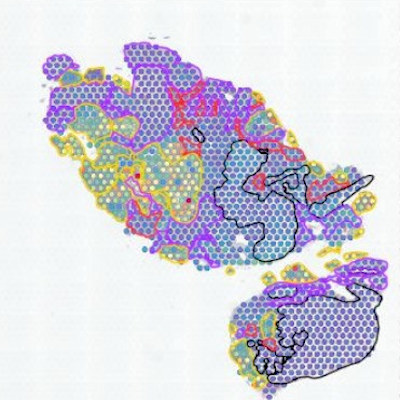June 11, 2021 -- Building on the success of single-cell technologies, 10X Genomics' Michael Schnall-Levin, PhD, discusses with ScienceBoard.net how the company entered the spatial biology field and how it continues to support the advancement of various clinical translational research efforts.
Schnall-Levin is a mathematician by training but pivoted early in his career to use computational methods to understand genetics, evolution, and other parts of biology. He met the now-CEO of 10X Genomics, Serge Saxonov, PhD, in 2012 and decided to join the team in the company's foundational stage. Schnall-Levin is now senior vice president of research and development at 10X Genomics.
10X Genomics is a developer of spatial transcriptomics molecular profiling methodology that allows scientists to measure the gene activity in a tissue sample and map where the activity is occurring. The technology uses spatially barcoded messenger RNA (mRNA)-binding oligonucleotides to capture probes, thereby allowing scientists to capture gene expression information of patient samples.
The company's Visium platform is used in a number of translational research areas including biomarker discovery, engineered immune cell therapy, and clinical trial development. One of the key benefits of the platform is the potential to collect data directly from patient samples.
Because of its far-reaching applications in clinical research, 10X Genomics established the Visium Clinical Translational Research Network (CTRN), a collaboration with the global research community that is dedicated to the acceleration of clinical translational research. The first group of members included 45 scientists from 39 institutions around the globe that are focused on a diverse array of research topics. In 2021, 10X Genomics added an additional 30 members to the network.
The network brings together a large group of researchers to share technology use cases with an eye on clinical adaptation. As part of the collaboration, scientists offer input on how they would like to use the technology in the future and provide feedback to ensure that the technology is serving their current research needs.
In the discussion, Schnall-Levin explained the value of the new spatially resolved data type in being able to understand disease and treatment options. Along with this must come data standardization, which is crucial for being able to identify the differences between true biology and what can be accounted for with variation among different lab usages.
Since the company's inception, over 2,500 scientific research articles citing the use of 10X Genomics' single-cell or spatial biology tools have been published.
"It's been pretty exciting to see all of the different applications," Schnall-Levin said.
To find out more about the program and how to become involved, visit 10X Genomics' Visium CTRN website.
Copyright © 2021 scienceboard.net









